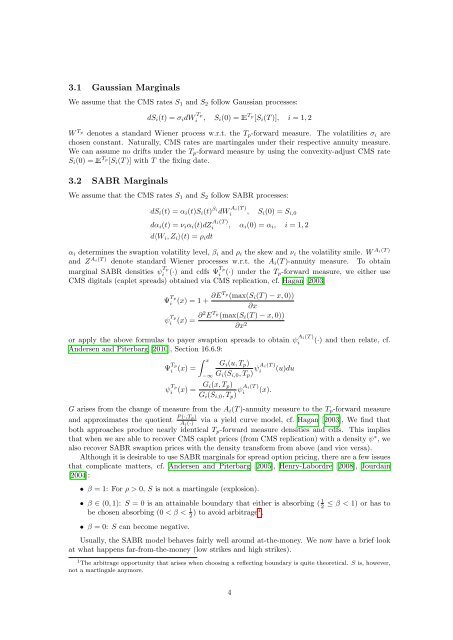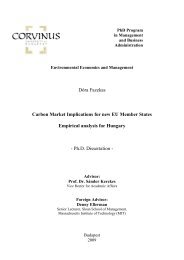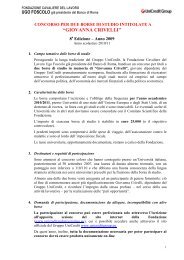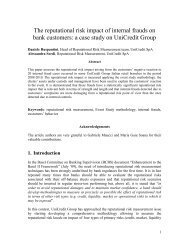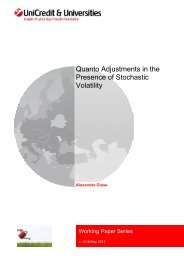Consistent Pricing of CMS and CMS Spread Options - UniCredit ...
Consistent Pricing of CMS and CMS Spread Options - UniCredit ...
Consistent Pricing of CMS and CMS Spread Options - UniCredit ...
Create successful ePaper yourself
Turn your PDF publications into a flip-book with our unique Google optimized e-Paper software.
3.1 Gaussian Marginals<br />
We assume that the <strong>CMS</strong> rates S1 <strong>and</strong> S2 follow Gaussian processes:<br />
dSi(t) = σidW Tp<br />
i , Si(0) = Tp [Si(T )], i = 1, 2<br />
W Tp denotes a st<strong>and</strong>ard Wiener process w.r.t. the Tp-forward measure. The volatilities σi are<br />
chosen constant. Naturally, <strong>CMS</strong> rates are martingales under their respective annuity measure.<br />
We can assume no drifts under the Tp-forward measure by using the convexity-adjust <strong>CMS</strong> rate<br />
Si(0) = Tp [Si(T )] with T the fixing date.<br />
3.2 SABR Marginals<br />
We assume that the <strong>CMS</strong> rates S1 <strong>and</strong> S2 follow SABR processes:<br />
dSi(t) = αi(t)Si(t) βi Ai(T )<br />
dWi , Si(0) = Si,0<br />
Ai(T )<br />
dαi(t) = νiαi(t)dZi ,<br />
d〈Wi, Zi〉(t) = ρidt<br />
αi(0) = αi, i = 1, 2<br />
Ai(T )<br />
αi determines the swaption volatility level, βi <strong>and</strong> ρi the skew <strong>and</strong> νi the volatility smile. W<br />
<strong>and</strong> ZAi(T ) denote st<strong>and</strong>ard Wiener processes w.r.t. the Ai(T )-annuity measure. To obtain<br />
marginal SABR densities ψ Tp<br />
i<br />
(·) <strong>and</strong> cdfs ΨTp<br />
i (·) under the Tp-forward measure, we either use<br />
<strong>CMS</strong> digitals (caplet spreads) obtained via <strong>CMS</strong> replication, cf. Hagan [2003]<br />
Ψ Tp<br />
i (x) = 1 + ∂ETp (max(Si(T ) − x, 0))<br />
∂x<br />
ψ Tp<br />
i (x) = ∂2E Tp (max(Si(T ) − x, 0))<br />
∂x2 or apply the above formulas to payer swaption spreads to obtain ψ<br />
Andersen <strong>and</strong> Piterbarg [2010], Section 16.6.9:<br />
Ψ Tp<br />
i (x) =<br />
x<br />
−∞<br />
Gi(u, Tp)<br />
Gi(Si,0, Tp)<br />
ψ Tp<br />
i (x) = Gi(x, Tp)<br />
Gi(Si,0, Tp)<br />
)<br />
ψAi(T i (u)du<br />
)<br />
ψAi(T i (x).<br />
Ai(T )<br />
i<br />
(·) <strong>and</strong> then relate, cf.<br />
G arises from the change <strong>of</strong> measure from the Ai(T )-annuity measure to the Tp-forward measure<br />
P (·,Tp)<br />
<strong>and</strong> approximates the quotient Ai(·) via a yield curve model, cf. Hagan [2003], We find that<br />
both approaches produce nearly identical Tp-forward measure densities <strong>and</strong> cdfs. This implies<br />
that when we are able to recover <strong>CMS</strong> caplet prices (from <strong>CMS</strong> replication) with a density ψ∗ , we<br />
also recover SABR swaption prices with the density transform from above (<strong>and</strong> vice versa).<br />
Although it is desirable to use SABR marginals for spread option pricing, there are a few issues<br />
that complicate matters, cf. Andersen <strong>and</strong> Piterbarg [2005], Henry-Labordre [2008], Jourdain<br />
[2004]:<br />
• β = 1: For ρ > 0, S is not a martingale (explosion).<br />
• β ∈ (0, 1): S = 0 is an attainable boundary that either is absorbing ( 1 ≤ β < 1) or has to<br />
be chosen absorbing (0 < β < 1<br />
2 ) to avoid arbitrage1 .<br />
• β = 0: S can become negative.<br />
Usually, the SABR model behaves fairly well around at-the-money. We now have a brief look<br />
at what happens far-from-the-money (low strikes <strong>and</strong> high strikes).<br />
1 The arbitrage opportunity that arises when choosing a reflecting boundary is quite theoretical. S is, however,<br />
not a martingale anymore.<br />
4<br />
2


